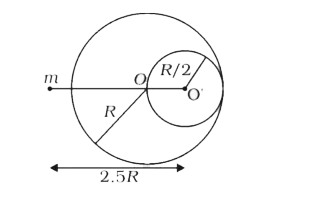Consider sunlight incident on a slit of width 104Å . The image seen through the slit shall
be a fine sharp slit white in colour at the centre
a bright slit white at the centre diffusing to zero intensities at the edges
a bright slit white at the centre diffusing to regions of different colours
only be a diffused slit white in colour
The correct Answer is:A
To solve the problem, we need to analyze the situation of sunlight passing through a slit of width 10^4 \, \text{Å} (angstroms).
1. Identify the Width of the Slit:
The width of the slit is given as 104Å. Converting this to a more manageable unit:
104Å=10,000Å
2. Understand the Visible Light Range:
The visible spectrum of light ranges approximately from 3900Å to 7000Å. This means that the light we can see falls within this range.
3. Compare the Slit Width with the Visible Light Range:
Since the width of the slit 10,000Å is much larger than the maximum wavelength of visible light (7000Å), we can conclude:
Width of slit≫Wavelength of visible light
4. Determine the Effect of the Slit Width:
When the slit width is significantly larger than the wavelength of light, diffraction effects are negligible. This means that light will pass through the slit without spreading out significantly.
5. Analyze the Resulting Image:
Since sunlight is composed of all colors (white light), and there is no significant diffraction, the light will appear as a sharp image. Thus, the image seen through the slit will be:
A fine sharp white light at the center
6. Select the Correct Option:
Based on our analysis, the correct description of the image seen through the slit is:
- A fine sharp slit white in color at the center.
Conclusion:
The correct answer is the first option: "A fine sharp slit white in color at the center."
The width of the slit is given as 104Å. Converting this to a more manageable unit:
104Å=10,000Å
The visible spectrum of light ranges approximately from 3900Å to 7000Å. This means that the light we can see falls within this range.
Since the width of the slit 10,000Å is much larger than the maximum wavelength of visible light (7000Å), we can conclude:
Width of slit≫Wavelength of visible light
When the slit width is significantly larger than the wavelength of light, diffraction effects are negligible. This means that light will pass through the slit without spreading out significantly.
Since sunlight is composed of all colors (white light), and there is no significant diffraction, the light will appear as a sharp image. Thus, the image seen through the slit will be:
A fine sharp white light at the center
Based on our analysis, the correct description of the image seen through the slit is:
- A fine sharp slit white in color at the center.
The correct answer is the first option: "A fine sharp slit white in color at the center."
Topper's Solved these Questions
- WAVE OPTICSBOOK - NCERT FINGERTPS ENGLISHCHAPTER - WAVE OPTICSEXERCISE - ASSERTION & REASON CORNER
15 Videos
- WAVE OPTICSBOOK - NCERT FINGERTPS ENGLISHCHAPTER - WAVE OPTICSEXERCISE - Huygens Principle
4 Videos
- WAVE OPTICSBOOK - NCERT FINGERTPS ENGLISHCHAPTER - WAVE OPTICSEXERCISE - HIGHER ORDER THINKING SKILLS
8 Videos
- SEMICONDUCTOR ELECTRONICS : MATERIALS , DEVICES AND SIMPLE CIRCUITS BOOK - NCERT FINGERTPS ENGLISHCHAPTER - SEMICONDUCTOR ELECTRONICS : MATERIALS , DEVICES AND SIMPLE CIRCUITS EXERCISE - Assertion And Reason
15 Videos
Similar Questions
A solid sphere of radius R/2 is cut out of a solid sphere of radius R such that the spherical cavity so formed touches the surface on one side and the centre of the sphere on the other side, as shown. The initial mass of the solid sphere was M. If a particle of mass m is placed at a distance 2.5R from the centre of the cavity, then what is the gravitational attraction on the mass m?

View SolutionConsider sunlight incident on a pinhole of width 103Å. The image of the pinhole seen on a screen shall be
View Solution
Knowledge Check
A parallel beam of light of wavelength 600 nm is incident normally on a slit of width d. If the distance between the slits and the screen is 0.8 m and the distance of 2nd order maximum from the centre of the screen is 15 mm. The width of the slit is
A40μmB80μmC160μmD200μm
Monochromatic light of wavelength 580 nm is incident on a slit of width 0.30 mm. The screen is 2m from the slit . The width of the central maximum is
View SolutionLight of wavelength 6000Å is incident on a slit of width 0.30 mm. The screen is placed 2 m from the slit. Find (a) the position of the first dark fringe and (b). The width of the central bright fringe.
View SolutionLight of wavelength 6328Å is incident normally on a slit having a width of 0.2mm. The distance of the screen from the slit is 0.9m. The angular width of the central maximum is
View SolutionA plane wave of wavelength 6250Å is incident normally on a slit of width 2×10−2 cm The width of the principal maximum of diffraction pattern on a screen at a distance of 50 cm will be
View SolutionLight of wavelength 6000Å is incident on a slit of width 0.30 mm. The screen is placed 2 m from the slit. Find (a) the position of the first dark fringe and (b). The width of the central bright fringe.
View SolutionLight of wavelength 5000Å is incident over a slit of width 1μm. The angular width of central maxima will be
View SolutionLight of wavelength 5000 Å is incident on a slit of width 0.1 mm. Find out the width of the central bright line on a screen distance 2m from the slit?
View Solution
